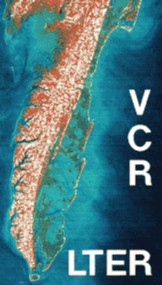 SUSCEPTIBILITY OF SALT MARSH SEDIMENT DISSOLVED ORGANIC CARBON TO MICROBIAL METABOLISM IN FOUR VEGETATION ZONES. |

Jennifer D. Aiosa and Linda K. Blum
Laboratory of Microbial Ecology
|
 SUSCEPTIBILITY OF SALT MARSH SEDIMENT DISSOLVED ORGANIC CARBON TO MICROBIAL METABOLISM IN FOUR VEGETATION ZONES. |

Jennifer D. Aiosa and Linda K. Blum
Laboratory of Microbial Ecology
|
Changes in salt marsh sediment organic matter content may be directly attributed to altered patterns of tidal flooding frequency or may be related to differences in the susceptibility of each zone’s characteristic vegetation to decay. Microbial decay of organic matter consists of the conversion of particulate organic material to dissolved organic material (DOM), a form assimilated and metabolized by microbial cells. Therefore, the quantity and quality of DOM in sediment pore water may be an indicator of the susceptibility of sediment organic matter to mineralization or burial. For example, low concentrations of labile DOM would suggest rapid turnover of DOM and organic matter mineralization, while high concentrations of refractory DOM would indicate slow turnover, long residence times, and the potential for organic material accumulation. We hypothesized that i.) sediment pore water concentrations of DOM would increase as inundation frequency decreases and ii.) that DOM in frequently flooded sediments is more readily converted to bacterial biomass than DOM in less frequently flooded sediments.
Dissolved organic carbon (DOC) concentrations and microbial metabolism of DOC from salt marsh sediments were measured in four plant zones (tall-form Spartina alterniflora - TS; short-form S. alterniflora - SS; Juncus roemerianus - J; and Spartina patens - P). These plant zones differ in elevation and distance from the tidal creek which floods upper Phillips Creek marsh so that the sites differ in the frequency and duration of flooding (Fig. 2). The relationship between the source of DOC and measures of DOC availability to bacteria is not clear (Fig. 3). Within treatment variation was so great that no difference was detected between the control and treatment means (a = 0.05). However, it is tempting to speculate that the ability of bacteria to use DOC for biomass production is related to plant type and warrants further examination.